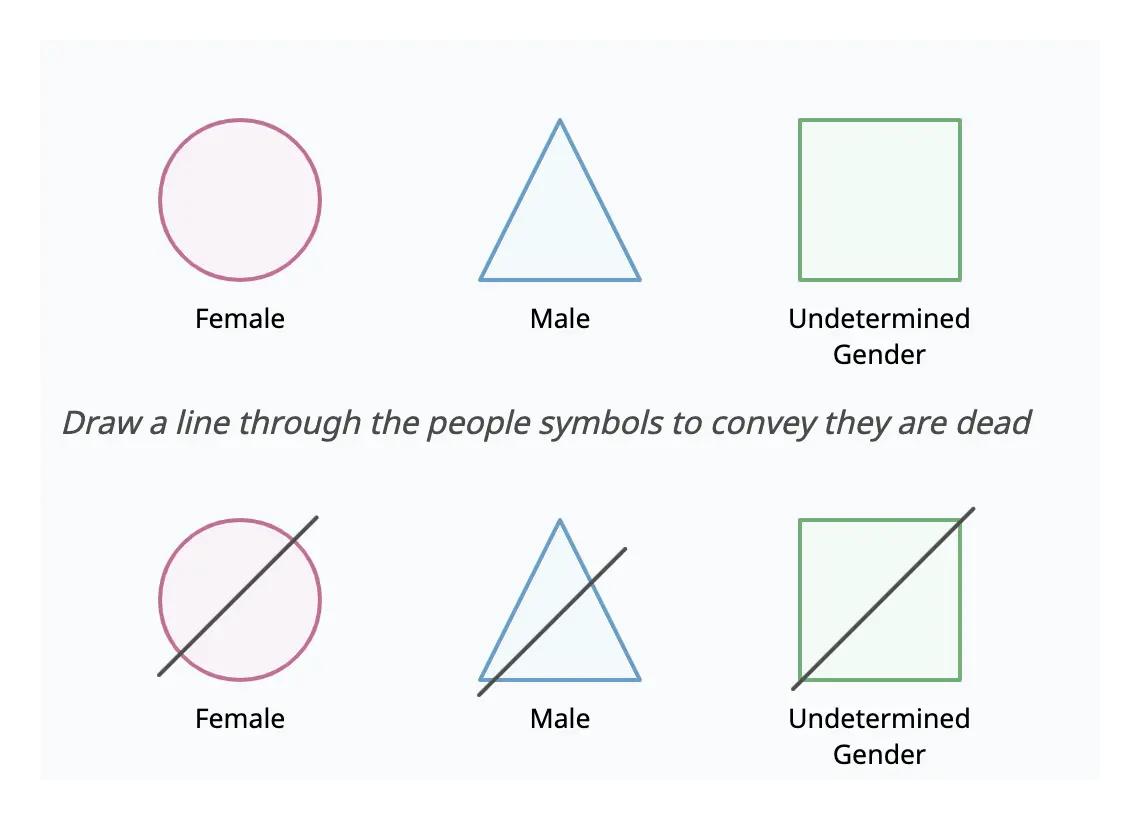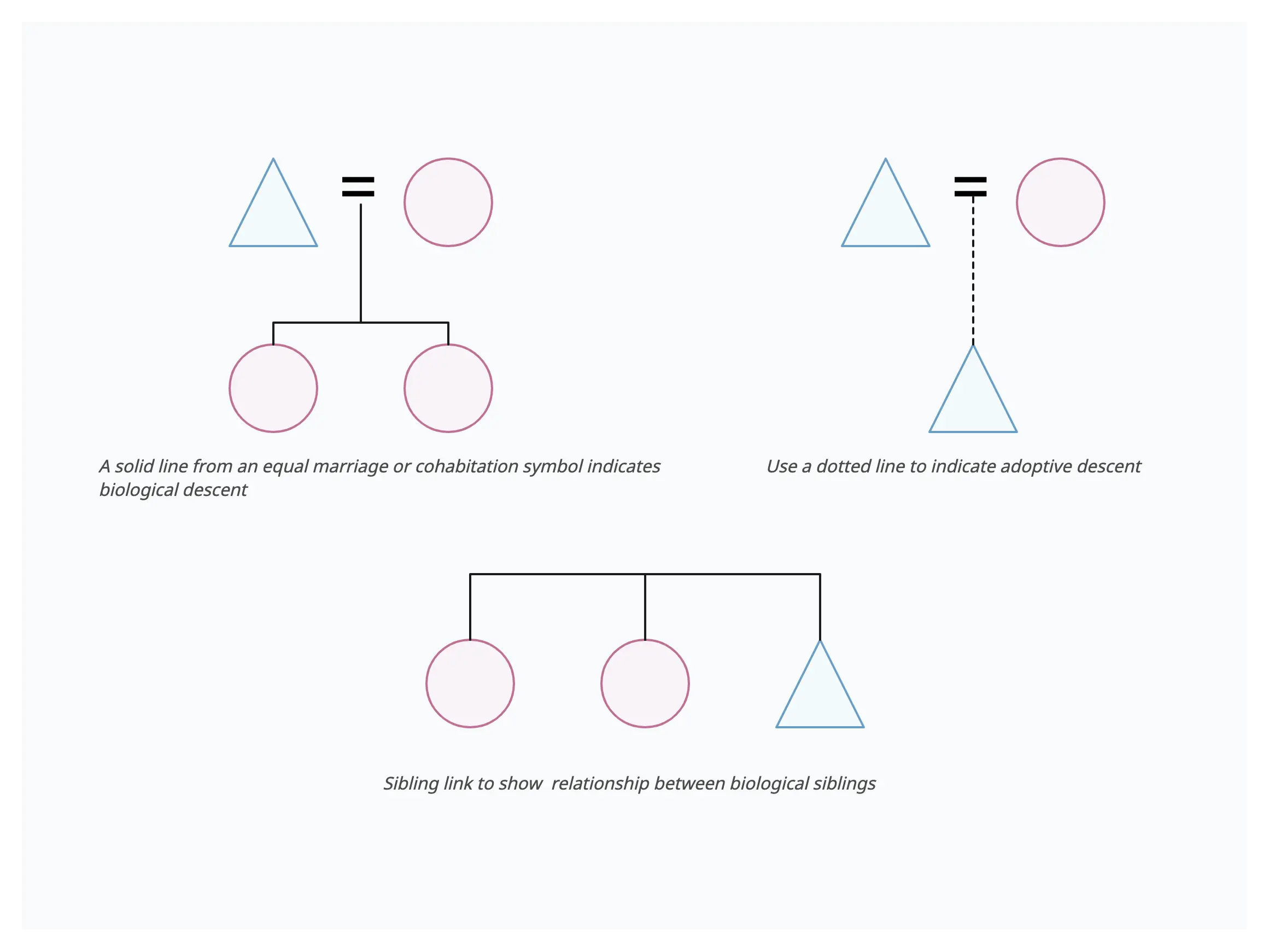Kinship diagrams offer a simplified yet informative way to explore family history. They offer a clear snapshot of lineage, descent, and the complexities of extended kin networks. From tracing the roots of a family tree to understanding the dynamics of larger ancestral connections, kinship diagrams play an important role in genealogy, anthropology, and sociology.
In this blog post we will discuss the most common types of kinship diagrams, how to create your own, and examples of kinship diagrams in action for different purposes like medical pedigree charts and ancestry mapping.
What is a Kinship Diagram
A kinship diagram is a visual representation of the biological relationships between individuals within a family or extended family. Kinship diagrams use symbols like circles and triangles to represent people, and lines to represent relationships. They can help to clarify family connections and identify biological relationships. Kinship diagrams can be used to clarify complex family trees, visualize hereditary patterns for medical conditions, and trace ancestry or genealogy.
Key characteristics of kinship diagrams,
They use standardized symbols to represent different types of relationships. For example, a circle typically represents a female and a triangle represents a male. Lines show relationships like parent-child, sibling, and grandparent.
Kinship diagrams can show both vertical and horizontal relationships. Vertical lines show parent-child connections across generations, while horizontal lines show sibling relationships within the same generation.
They often start with an “ego,” the individual at the center of interest. Lines then extend out to show that person’s immediate family members, and then their family members, and so on.
Kinship diagrams are used in genealogy and family history research to map out family trees and connections. They can also be helpful for identifying hereditary health conditions that run in families.
More complex kinship diagrams use additional symbols to represent things like marriage, divorce, adoption, and half-siblings. They can become quite extensive for large, multi-generational families.
Kinship Diagram Symbols
Kinship diagrams use symbols to represent different individuals, their gender, and the nature of their relationships. Here are some common symbols used in kinship diagrams.
Basic kinship symbols

Marriage and cohabitation

Descent

Kinship Diagram Templates
Get started creating your own Kinship diagram with these ready-to-use templates.
Kinship Diagram Example
Kinship Chart
Anthropology Kinship Diagram
Kinship Diagram Template
Kinship Diagram Template
How to Make a Kinship Diagram
Follow these simple steps to create your own Kinship diagram.
Step 1: Identify family members and relationships
Begin by listing the individuals you want to include in your diagram. Gather information on them and their relationships. This includes names, dates of birth, and relationships like mother, father, son, daughter, aunt, uncle, grandparent, and so on.
Step 2: Draw the kinship diagram
- Begin your kinship diagram by placing “Ego” (the central person around whom the diagram revolves) at the top or center of the page.
- Draw lines connecting Ego to immediate family members, such as parents, siblings, and possibly children if applicable. Use standard kinship notation like triangles for males and circles for females.
- Extend the diagram by adding more family members and their relationships. Use lines to connect spouses and children, and continue following kinship notation rules for symbols.
- Indicate important life events such as marriages, births, or deaths. You can use symbols or labels to represent these events. For example, use the equal sign for marriages or a line through the male or female symbol to indicate deaths.
Step 3: Include additional information
Include notes or comments alongside specific individuals to record additional information like birth dates, marriage dates, or any other noteworthy details. This adds depth to your kinship diagram.
Step 5: Color and design
Consider using colors or different line styles to distinguish between branches or generations. If you have specific rules for descent (e.g., differentiating between maternal and paternal lines), consider using different colors or styles to make these distinctions clear. This makes the diagram more visually appealing and easier to follow.
Step 6: Review and edit
Take a step back and review your kinship diagram. Make sure all relationships are accurately represented. Make any necessary adjustments or corrections.
When to Use Kinship Diagrams
Kinship diagrams are useful in various contexts and for different purposes. Here are some situations where kinship diagrams can be particularly useful:
- Genealogy and family history: Kinship diagrams are helpful for visualizing relationships, understanding ancestral connections, and preserving family history.
- Cultural anthropology: Anthropologists use kinship diagrams to study and analyze social structures within different cultures, helping to understand kinship systems, marriage patterns, and societal organization.
- Sociological studies: Sociologists use kinship diagrams to explore family structures, roles, and relationships within societies. They provide insights into how families are organized and function in different social contexts.
- Medical genetics: Kinship diagrams can help healthcare professionals understand potential health risks by illustrating family medical histories, genetic traits, and hereditary diseases.
- Educational purposes: Teachers and educators use kinship diagrams to teach students about family structures, relationships, and genealogy.
Benefits of Kinship Diagrams
Organize family relationships. Kinship diagrams provide an organized visual representation of family relationships. This makes it easy to identify blood relatives, their degree of relatedness, and their role in the family.
Understand inheritance patterns. Kinship diagrams can help determine how genetic traits and conditions are passed down through generations. This is useful for identifying risks of inheriting certain genetic diseases or conditions.
Clarify legal relationships. Kinship diagrams can clarify legal relationships for determining things like inheritance, next of kin, custody rights, and other legal matters involving family members.
Identify ancestral lineages. Kinship diagrams tracing multiple generations can help identify ancestral lineages, family trees, and determine the degree of relatedness between distant relatives. This is useful for genealogy research and learning more about family history.
Assist with genetic research. Kinship diagrams mapping genetic traits through generations can assist researchers studying the heritability and inheritance patterns of certain genetic conditions.
Tips for Creating Effective Kinship Diagrams
Begin with a central person, like yourself or someone important in your family, at the center of the page.
Check for accuracy. Double check the diagram by reviewing it with family members to ensure all relationships and names are correct.
Arrange family members from the oldest at the top to the youngest at the bottom. This helps to see who came before and after in your family.
Use color and space wisely. Employ color and spacing to help visually organize the diagram and distinguish between different sides of the family or generations.
Explain with a key. If you’re using special symbols or colors, make a little key or legend to explain what each of them means.
Add little notes or comments to share more details about each family member. This could be their birthdays or any special information you want to remember.
Who can use a Kinship Diagram?
Kinship diagrams are not just academic tools; they serve a variety of users across different fields. Here are some of the key groups that benefit from using kinship diagram templates:
Genealogists mapping out family histories: By creating detailed kinship charts, genealogists can trace lineage and familial connections, often uncovering fascinating stories and patterns that span generations.
Anthropologists studying cultural and societal relationships: Kinship diagrams are invaluable for anthropologists who analyze how different societies understand family structures and social bonds.
Individuals interested in visualizing and preserving their family lineage: For those who take pride in their heritage, a kinship diagram is a way to visualize and document family ties, ensuring that this information is preserved for future generations.
Educators and students using kinship diagrams for learning about social structures: In educational settings, kinship diagrams can be a powerful tool for teaching about social organization, family dynamics, and cultural norms.
Use Creately to Draw Your Kinship Diagram
Creately ’s kinship diagram maker comes equipped with easy drawing tools and advanced diagramming capabilities to simplify creating detailed kinship diagrams.
Infinite canvas to host large societal structures together and visualize complex relationships with ease.
Simple to use drag and drop tools to arrange the relationships types and build detailed kinship diagrams.
Integrated notes and data fields to add additional information to specific symbols in a kinship diagram- to clarify relationship types and details.
Multiple ready-to-use kinship diagram templates to get a head start and comprehensive shape libraries for kinship diagrams, genograms, and more to visualize family relationships.
Import images, vectors, and more on to the canvas to visualize kinship diagrams or use built-in Google image search to explore more symbols.
Collaborate with anyone in real-time with live mouse tracking, synced previews and contextual comments to clarify things.
Spotlight and presentation mode to conduct interactive and dynamic presentations right on the canvas.
In conclusion, kinship diagrams provide a useful visual representation of family relationships and genetic inheritance. They highlight how family members are biologically related, helping to identify potential health risks and genetic conditions that run in families. With this knowledge, individuals gain a better understanding of their ancestry and health history, which can improve decision making around medical screenings and treatments. Kinship diagrams provide a simple yet powerful tool for exploring the connections within our families.






